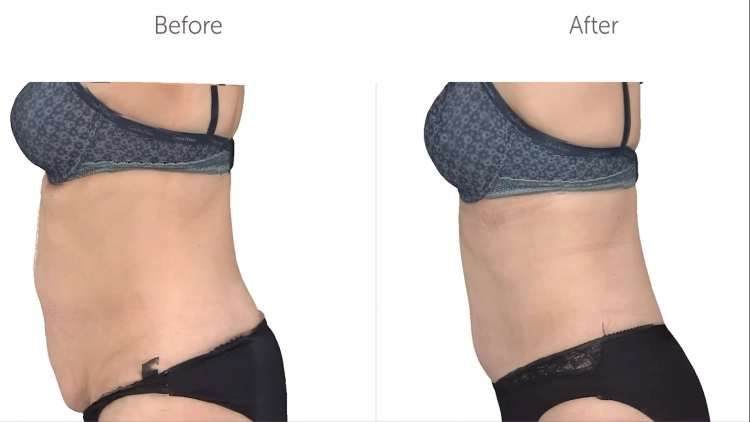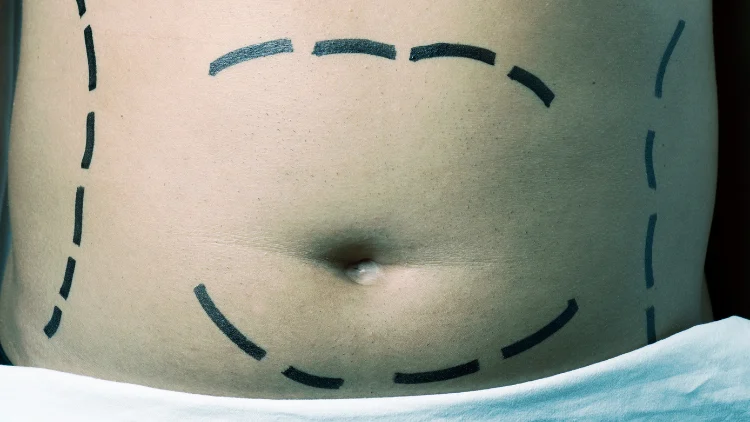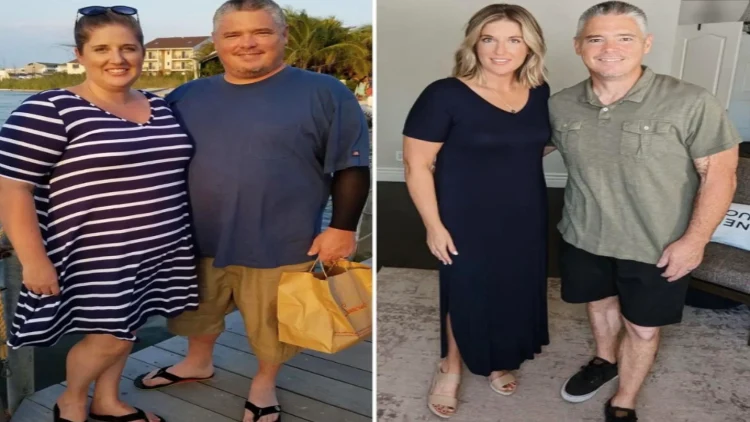
Many people who get an abdominoplasty–the formal name of a tummy tuck–are likely wondering if it’s common to slim down after a tummy tuck, how much weight can be lost through the removal of excess skin and how to keep the recently removed fat from coming back.1
Those considering this procedure have often already lost a considerable amount of weight and want to have their loose skin removed with a tummy tuck, so we’ll cover post-tummy tuck weight loss strategies and how to lose even more fat after the procedure–and keep it off.
We’ll also explain what other weight loss surgeries are available and share a few stories of weight loss tummy tuck before and after photos for inspiration.
How To Lose Weight After a Tummy Tuck
To answer the question of do you slim down after a tummy tuck, yes you do–due to the excess skin and fat that is removed. The connective tissues covering the abdominal muscles are also tightened to strengthen the abdominal wall muscles during an abdominoplasty.2
However, whether someone maintains this weight loss, loses even more weight, or lets the pounds creep back on varies.
Continuing to lose weight after a tummy tuck requires commitment, regular exercise, self-control, and either following weight loss diets or eating clean and avoiding overindulgence.
Since the ideal candidate for a tummy tuck has already reached their goal weight but has extra skin or fat that can’t be decreased further without surgical intervention, it’s important that someone going in for this procedure knows the restrictions and doesn’t plan to either get pregnant or follow the same eating habits and lifestyle they did at their highest weight.
Doing so would make the tummy tuck pointless and since this operation is not only costly but comes with some risks, it should be taken seriously and the eating and exercise restrictions followed afterwards.
This requires eating smaller portions, following doctor-recommended activity levels or exercises, and a lot of psychological determination–but it can be done with the right mindset and dedication.
How Much Weight Do You Shed From a Tummy Tuck
How much weight do you shed from a tummy tuck varies somewhat, but on average a standard tummy tuck will require an incision along the bikini line from hip to hip with another smaller incision near the belly button and will remove approximately 4 pounds of fat and excess skin during a 1-3 hour procedure.
A mini tuck refers to the same procedure but with a smaller incision, used if the patient doesn’t need as much fat or skin removed and can take off about 3 pounds. An extended tummy tuck’s incision goes all the way to the back and removes even more skin and fat–about 5 pounds for most people, but can go up to 10 pounds or even more removed in the extended tuck which can take 5-6 hours.

Source: Jason Moyano via Canva.com3
It all depends on one’s starting weight, current weight, body composition, and skin elasticity but the average weight loss after tummy tuck is about 5 pounds. To determine whether you’re dealing with fat or loose skin when considering a tummy tuck, you can try a visual assessment, a pinch test, or get a DEXA scan.
Weight Loss Tummy Tuck Before & After Photos & Results
When considering any type of surgery or procedure, it can be inspiring to see others’ results and can calm nerves to hear about positive outcomes; let’s check out a few people who’ve had successful tummy tucks done, their stories, and before and after photos to show the incredible difference that an abdominoplasty can make.
Laura & Chris
Laura and Chris are a married couple in their 40s who lost over 100 pounds each following a carnivore diet. They lost this weight around 2018 and had each maintained for over 4 years but with a lot of extra skin and fat.
After realizing that maintaining fat loss and getting fit didn’t do anything to the loose skin, they decided to get tummy tucks to help them feel as great as they look. At the end of 2022, they each had their procedures done–an extended tummy tuck including diastasis recti muscle repair and Laura had liposuction done on her love handles.

Through their dedication to a carnivore diet, Laura and Chris lost over 100 pounds each, but with the realization that excess skin and fat remained, they underwent tummy tucks at the end of 2022, feeling and looking great. Source: @Lauraespath on Instagram4
They’re both feeling amazing and more energetic to keep up with their kids; additionally, Chris had been a type 2 diabetic and was on several medications to manage blood sugar, blood pressure, sleep apnea, and joint pain. He no longer takes any medications or supplements and has reversed all of his health conditions.
Laura said sometimes she still can’t believe she’s the same person when she looks in the mirror!
Cali
Cali had already shed pounds of weight and continued to lose weight after a tummy tuck, mentioning that she had been obese most of her life and decided to take control of her health and lose the excess weight. Cali ended up following the ketogenic diet and took up running, losing 150 lbs on her own.

Cali took control of her life and health, losing 150 lbs on her own through a ketogenic diet and running. Source: @caliketogirl on TikTok5

After a tummy tuck, she continues to thrive on her journey towards a healthier and happier self. Source: @caliketogirl on TikTok
After some traumatic life events and feeling discouraged, Cali jumped back into her fitness journey by incorporating weight lifting and hiking and eventually got an abdominoplasty to remove the last of the excess fat and skin. She said that the procedure and recovery were painful but that “every day gets better…so worth it!”
Procedures That Are Effective for Weight Loss
Tummy tucks are one of the most commonly requested aesthetic procedures in the U.S. and while they’re generally considered safe, it’s important to do your research and ensure you’re getting a safe tummy tuck from a plastic surgeon who is experienced, has high patient satisfaction, leaves minimal scarring, and is constantly up to date on risks and potential improvements.6
In an assessment of cosmetic surgery safety it was determined that most elective and cosmetic surgeries were deemed safe as long as they were done in an accredited office with experienced, board-certified surgeons–but in relation to other aesthetic procedures the abdominoplasty was deemed less safe than liposuction.7
However, this higher risk or complication rate associated with getting an abdominoplasty can be at least partially attributed to the fact that tummy tucks are often paired with other procedures in the same visit (such as Brazilian butt lifts, breast augmentation or reduction, or liposuction)–therefore, it can be difficult to determine the true risk factor of a tummy tuck by itself since the combination of procedures drastically increases the complication rate and potential risk.8
Other surgeries effective for weight loss are listed below with their possible risks.
Panniculectomy: A panniculectomy is a weight loss procedure that functions to remove fat and excess skin that hangs from the stomach and abdomen, sometimes hanging all the way down to the knees in extreme cases of weight loss.
While the success rate is fairly high, panniculectomies do carry more risk as well–especially since those who get this procedure done often are in poor health to begin with and because remaining tissue can be damaged during the operation.9 While this procedure is done for overall health and aesthetic purposes, it should be carefully considered due to this risk factor.
Gastric Sleeve: A sleeve gastrectomy (gastric sleeve) refers to an operation in which a portion of the stomach is removed from the body, with the remaining portion (now much smaller) being formed into a sort of tube-shape and able to hold much less food. The goal is that with a smaller stomach, overeating will be uncomfortable and avoided–preferably leading to weight loss.
Gastric Bypass: Another of the weight loss methods available is a gastric bypass; this surgery entails connecting the stomach to the small intestine after the stomach is formed into a sort of pouch. This should only be done if weight loss and dietary changes are unproductive and if approved by a doctor due to medical necessity or obesity-related health risks. This procedure may be recommended if excessive weight causes a concern for further health issues including heart attack, sleep apnea, type 2 diabetes, or stroke.
As with all of these options, a gastric bypass should not be pursued unless one plans to stick to healthier lifestyle changes and follow a much more strict eating plan to avoid doing damage or reversing the effects of this surgery.
Liposuction: A tummy tuck and liposuction are often paired, as liposuction may precede a tummy tuck to remove some of the fat. As the name suggests, excess fat is suctioned out and can be performed in many areas of the body.
Liposuction is much less expensive and much less invasive than an abdominoplasty and is safer overall with the main risk being a reaction to the anesthesia.
Gastric Banding: A gastric banding surgery is both adjustable and reversible, and describes the procedure of putting a gastric band–commonly called a lap band–around the stomach to reduce capacity and encourage smaller portions due to feeling full sooner.
This surgery can come with several potential complications including constipation, obstruction, nausea, vomiting, or even gastric band slippage.
Food & Exercise Tips Immediately Following a Tummy Tuck
Most who have undergone a tummy tuck have lost a fair amount of weight and want to jump right back into their regimen. However, it’s important to allow proper recovery and healing before attempting to lose more weight or even maintain one’s current weight.
First, following basic weight loss advice for beginners and remembering to incorporate these 3 steps–proper eating, physical exercise, and developing a healthy lifestyle–can get you on the right track but it’s important to avoid doing too much, too soon. Let’s take a look at some more specific options for what to eat after a tummy tuck and which exercises are best for immediately after the procedure and once fully healed.
What To Eat After a Tummy Tuck
There are no strict rules or diet to follow after an abdominoplasty, but sticking to light meals and snacks for several days is recommended. Be sure to drink plenty of water and stay hydrated, then slowly transition to incorporating fruits, yogurt, soups, vegetables, and whole grains.
Ease into healthy eating habits as your body adjusts and always focus on appropriate serving sizes and proper nutrition.
Take eating healthy seriously to slim down after a tummy tuck, because regaining the weight can cause added scarring, stretch marks, loss of skin elasticity, and discouragement due to reversing the effects of the surgery.
Exercises That Are Best After Getting a Tummy Tuck
Minimal exercise should be done for 8-12 weeks after your procedure as the body heals; leisurely walking is advised to stay active without getting too intense and anything involving the abs should be avoided for this period, including powerlifting, running, or any competitive sports.
Since full recovery can take 2-6 months, stay in touch with your doctor or surgeon to determine when it’s safe to increase activity levels, incorporate workout routines, and achieve a total body workout.
Once fully healed, whether your goal is to slim down after a tummy tuck or maintain, it will finally be safe to incorporate ab exercises again; to re-strengthen the core after this long healing period, slowly work planks, crunches, yoga, and other ab-focused routines back into your regimen. However, it’s important to note that “spot training”, or working out one area to lose fat in that area is a myth and fat loss is ultimately the result of calories in vs calories out so fully body workout regimens are the best approach.
How To Maintain Weight & Slim Down After a Tummy (Lose More Fat & Prevent Weight Gain)
Those who have had a tummy tuck likely have experience with weight loss methods like surgery, dieting, or exercise, and maintaining or further reducing weight comes down to the same 3 steps for weight loss.
Food & “Dieting”: As mentioned, weight loss and maintenance boils down to calories in vs calories out although counting calories or dieting isn’t 100% necessary since intuitive eating or mindful eating alongside movement can result in a healthy weight and/or weight loss. It may be best to count calories but it’s not for everyone.
The most important thing is burning more than you’re consuming or consuming as much as you’re burning. This can be done by choosing healthy, low calorie foods more frequently than not is one way to lower your calorie intake. So you can either count your calories or make healthier decisions for 2 weeks (this a fair amount of time to see if eating habits or exercise has made an impact) and see if you’ve lost weight or remained at the same weight. If you weight more it’s clear you were either eating too much or not moving enough and either of these can be achieved to lost or maintain weight.
Movement & “Exercise”: Exercising can be as simple as going for a walk, going for a run, or as complex as hitting the gym. The most important thing is to find something you enjoy and stick to it. Maybe that’s yoga, cycling, dancing, swimming, jump roping or any thing that increases your heart rate. Try to get 10k steps per day if possible and get 150 minutes of moderate intensity exercise a week but it’s perfectly fine to work your way up to these goals.
Stress, Sleep, & Mindset: No matter how hard you exercise and eat, if you’re not sleeping your progress will be lackluster. The same goes for stress and mindset is the cornerstone of perseverance so motivating yourself or seeking professional counseling such as therapy can prove fruitful.
We suggest the Waking Up app to lower stress levels and to practice mindfulness, a strict bedtime regimen with no blue light 1-2 hours before bed and limited caffeine and alcohol consumption to promote restful sleep, and journaling to unravel your current mindset and mood to get to the bottom of what motivates you and what’s stopping you from achieving your goals.
Above all, if you’ve had a tough day or week and feel discouraged or tempted to give up, remember all of the work you put in already, how far you’ve come, and your purpose.
If needed, find a supportive accountability partner who will help you stay on track. Tell yourself positive affirmations and keep working towards your goals as your long-term health is much more important than the procedure.
While many weight loss surgeries are available, an abdominoplasty or tummy tuck is a good option for those with excess skin or fat. All in all the answer is yes, you do slim down after a tummy tuck and you can keep it off by practicing mental fortitude, self-care, and a proper eating and exercise routine for long term success.
Frequently Asked Questions
How Much Do You Lose With a Tummy Tuck?
How much do you lose with a tummy tuck is hard to pinpoint because someone who gets a tummy tuck at 220 pounds will drop many more sizes than someone who has the procedure done at 350 pounds. Regardless, you’ll certainly drop in size no matter what since the average weight loss from the procedure alone is often 5-10 pounds.
Will a Tummy Tuck Make Me Less Hungry?
A tummy tuck is less effective than alternatives like a gastric sleeve or lap band in decreasing hunger, but since the tissue around the abdominal muscles is tightened, this could aid in appetite reduction.
Can You Gain Weight After a Tummy Tuck?
For those wondering can you gain weight after a tummy tuck, gaining weight after tummy tuck is certainly possible and is unfortunately rather common because it’s hard to break old eating habits; maintaining the weight loss all comes down to one’s habits, self-control, potential health conditions, and daily choices.
What Are the Weight Requirements for a Tummy Tuck?
There aren’t strict weight requirements for tummy tuck but it’s generally advisable that one’s BMI is under 35, they’re within 30% of their goal weight, generally healthy, and a non-smoker.
When Is a Tummy Tuck Not Recommended?
A tummy tuck may not be recommended for those who are still planning to lose a lot more weight, planning to become pregnant, smokers, or those who are at high risk of complications during the procedure.
The reason for waiting to get a tummy tuck when close to one’s goal weight is that if someone lost 20 pounds after tummy tuck, for example, they could end up with loose skin which would negate the purpose of the initial tummy tuck.
Should I Get a Tummy Tuck or Weight Loss Surgery?
A weight loss tummy tuck is more geared towards those who’ve lost significant weight and want to get rid of excess skin for aesthetic purposes while weight loss surgery is more targeted towards people who are having trouble losing weight naturally; this can help you decide what’s best for you, if either.
References
1Anthony Macquillan. “Abdominoplasty Before and After.” YouTube, 24 October 2019. Accessed 21 April 2023. <https://www.youtube.com/watch?v=wHkLIcsaSrs>
2Regan, J.-P. (2022, July 25). Abdominoplasty. National Institute of Health. Retrieved March 3, 2023, from <https://www.ncbi.nlm.nih.gov/books/NBK431058/>
3Juan Moyano. “Man Having a Plastic Surgery.” Canva, Accessed 5 April 2023. <https://www.canva.com/photos/MAC74018ojU-man-having-a-plastic-surgery/>
4@Lauraespath • Instagram photos and videos.” Instagram. Accessed 1 April 2023. <https://www.instagram.com/p/CjajPM1LkMf/?igshid=YmMyMTA2M2Y=>
5@caliketogirl. “My tummy tuck & Breast Aug Journey.” TikTok, Accessed 1 April 2023. <https://tiktok.com/t/ZTRWRLHQB>
6Chowdhry, S., Davis, J., Boyd, T., Choo, J., Brooks, R., Kelishadi, S., Tutela, J., Yonick, D., & Wilhelmi, B. (2015, June 17). Safe Tummy Tuck: Anatomy and Strategy to Avoid Injury to the Lateral Femoral Cutaneous Nerve During Abdominoplasty. Eplasty, 15. <https://www.ncbi.nlm.nih.gov/pmc/articles/PMC4473816/>
7Rohrich, R., Savetsky, I., & Avashia, Y. (2020, May). Assessing Cosmetic Surgery Safety: The Evolving Data. Plastic Reconstructive Surgery Global Open, 8(5), 2643. <https://www.ncbi.nlm.nih.gov/pmc/articles/PMC7572219/>
8Winocour, J., Gupta, V., Ramirez, J., Shack, R., Grotting, J., & Higdon, K. (2015, November). Abdominoplasty: Risk Factors, Complication Rates, and Safety of Combined Procedures. Plastic Reconstructive Surgery, 136(5), 597-606. <https://pubmed.ncbi.nlm.nih.gov/26505716/>
9Janis, J., Jefferson, R., & Kraft, C. (2020, August). Panniculectomy: Practical Pearls and Pitfalls. Plastic Reconstructive Surgery Global Open, 8(8), 3029. <https://www.ncbi.nlm.nih.gov/pmc/articles/PMC7489615/>